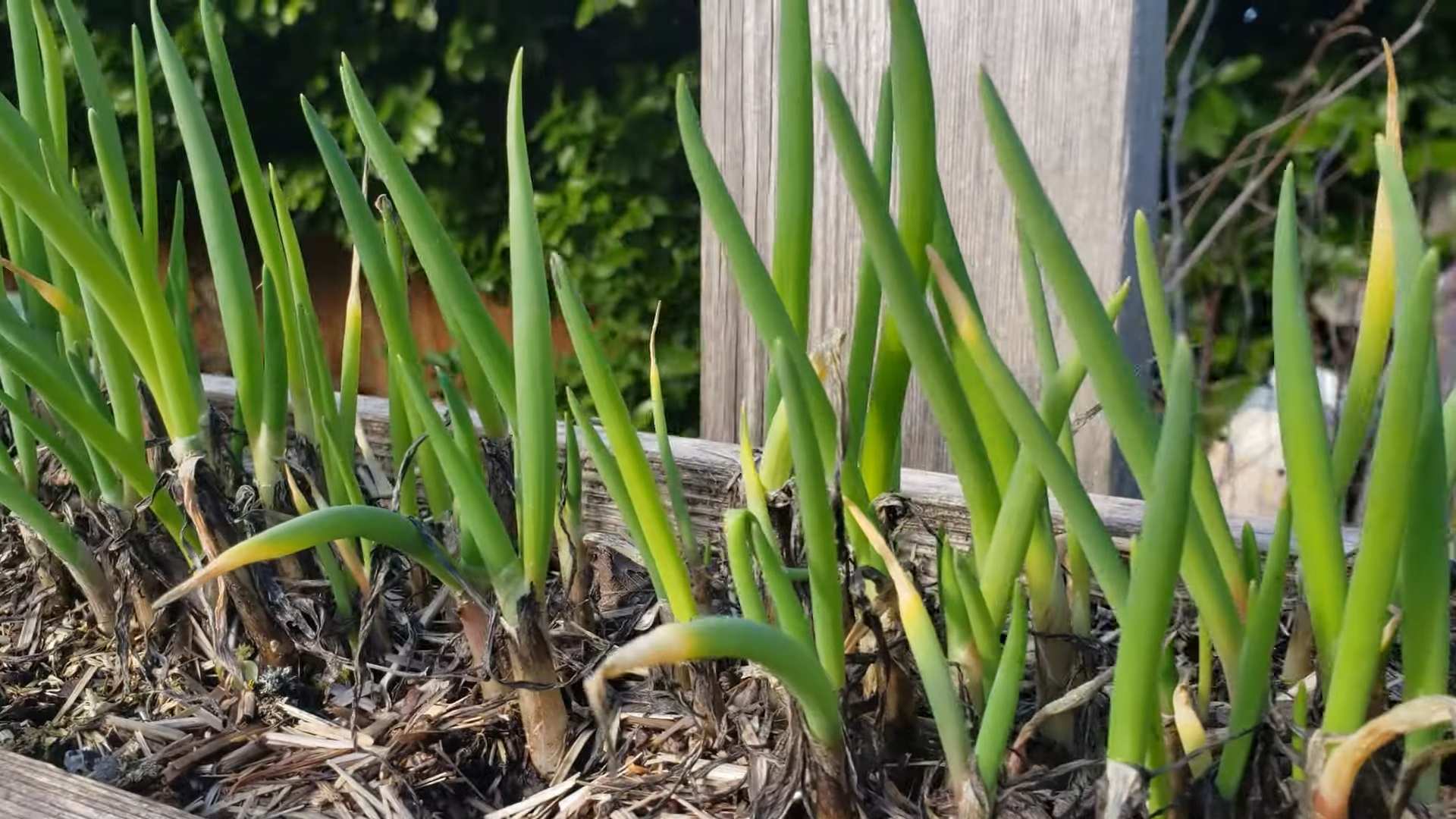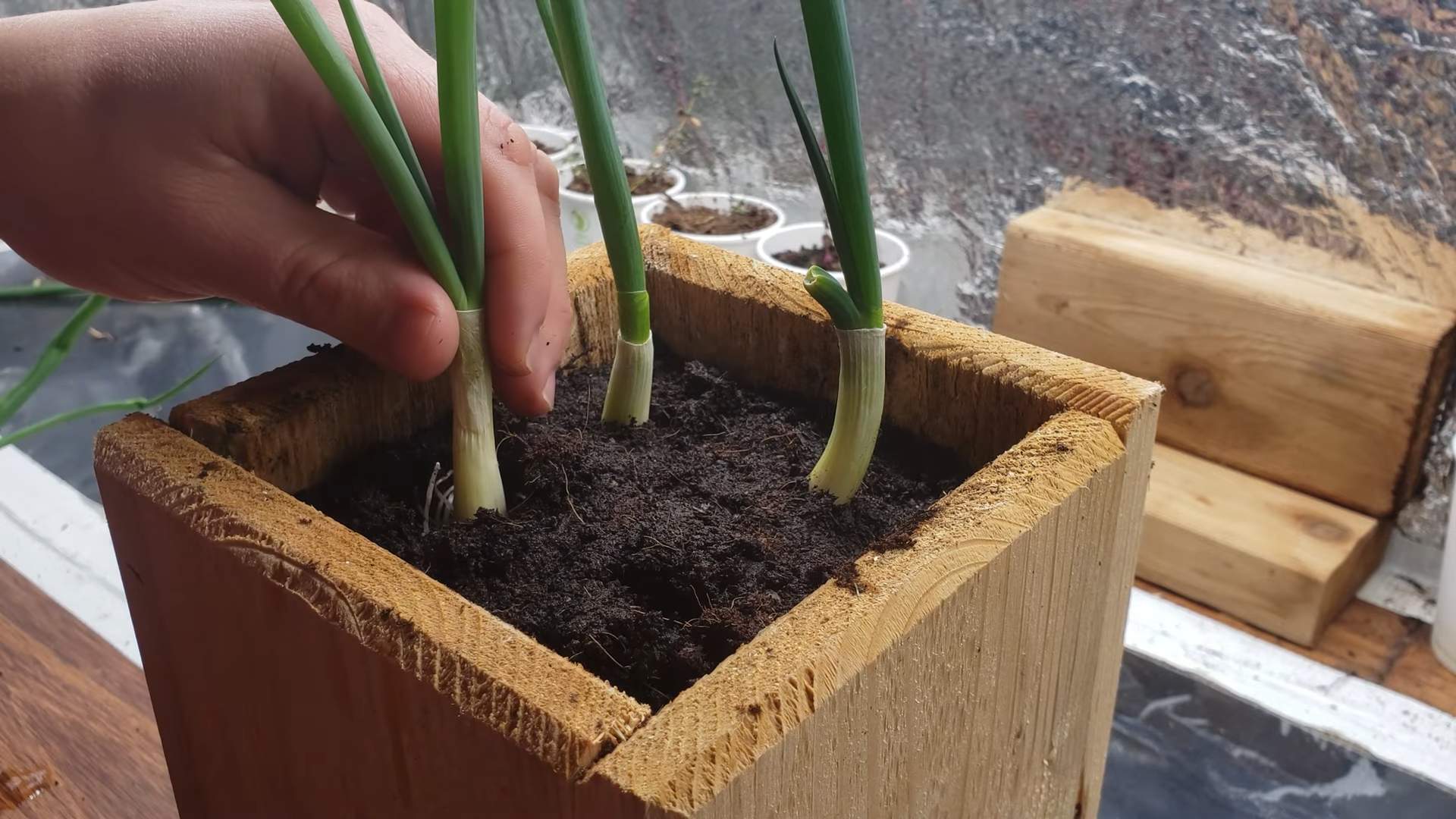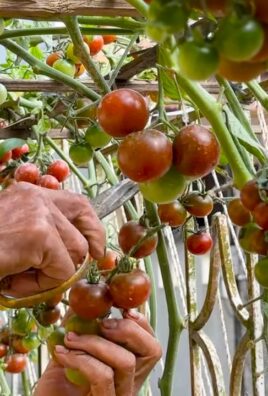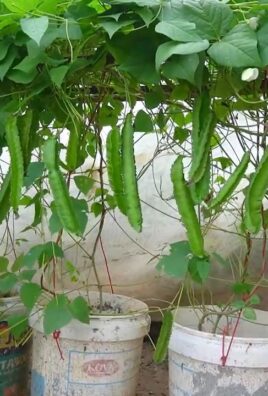Regrow Green Onions at Home: Never buy green onions again! Imagine a world where you always have fresh, flavorful green onions ready to snip and add to your favorite dishes. Sounds like a dream, right? Well, it’s a dream that can easily become a reality with this simple and incredibly rewarding DIY project.
For generations, resourceful cooks have understood the magic of propagating plants from scraps. This isn’t just a modern trend; it’s a time-honored tradition of making the most of what you have and connecting with nature. Think of it as a tiny act of rebellion against food waste, a little victory garden on your windowsill!
Let’s be honest, who hasn’t bought a bunch of green onions, used a few, and then watched the rest wilt away in the crisper drawer? It’s a common kitchen tragedy! But with this easy trick, you can say goodbye to that waste and hello to a continuous supply of fresh green onions. Not only will you save money, but you’ll also experience the satisfaction of nurturing something green and vibrant. So, are you ready to learn how to regrow green onions at home and transform your kitchen into a mini-garden? Let’s get started!

Regrow Green Onions: A Simple DIY Guide
Hey there, fellow green thumb enthusiasts! Are you tired of constantly buying green onions only to use a small portion and toss the rest? Well, I’ve got a fantastic solution for you: regrowing them at home! It’s super easy, cost-effective, and a great way to reduce food waste. Trust me, once you start, you’ll never look at a bunch of green onions the same way again. Let’s dive in!
What You’ll Need
Before we get started, let’s gather our supplies. The beauty of this project is that you probably already have most of these items lying around:
* A bunch of green onions (obviously!). Look for ones with healthy roots still attached.
* A small glass or jar.
* Water (tap water is fine).
* Scissors or a sharp knife.
* Potting soil (optional, for planting in soil later).
* A small pot (optional, for planting in soil later).
* A sunny windowsill.
Regrowing Green Onions in Water: Step-by-Step
This is the simplest method, perfect for beginners. I’ve been doing this for years, and it’s incredibly rewarding to see those little green shoots pop up again and again.
1. Prepare the Green Onions: Using your scissors or knife, cut off the green tops of the green onions, leaving about 1-2 inches of the white base and the roots intact. Don’t throw away the green tops! You can use them in your cooking right away. I usually chop them up and add them to salads, soups, or stir-fries.
2. Place in Water: Put the green onion bases, root-end down, into your glass or jar. Add enough water to cover the roots, but don’t submerge the entire white part of the onion. You want the top of the white part to be exposed to air.
3. Find a Sunny Spot: Place the glass or jar on a sunny windowsill. Green onions need sunlight to grow, so a bright location is crucial. A south-facing window is ideal, but any window that gets several hours of sunlight per day will work.
4. Change the Water Regularly: This is important! Change the water every 1-2 days to prevent bacteria growth and keep the water fresh. I usually do this in the morning when I’m making my coffee. It’s a quick and easy habit to get into.
5. Watch Them Grow: Within a few days, you should start to see new green shoots emerging from the tops of the green onion bases. It’s so exciting to watch! Continue to change the water regularly and provide plenty of sunlight.
6. Harvest and Repeat: Once the green shoots have grown to a usable length (usually a few inches), you can harvest them by cutting them off with scissors. Leave about an inch of the green shoots so they can continue to grow. The green onions will continue to regrow for several weeks, providing you with a continuous supply of fresh green onions. Eventually, the growth will slow down, and the onions may start to look a little tired. That’s when it’s time to move on to the next step: planting them in soil.
Planting Green Onions in Soil: For Long-Term Growth
While regrowing green onions in water is convenient, planting them in soil allows them to grow larger and stronger, and it extends their lifespan. I find that this method gives me the best results in the long run.
1. Choose a Pot: Select a small pot with drainage holes. The pot should be at least 6 inches in diameter to give the green onions enough room to grow.
2. Fill with Potting Soil: Fill the pot with high-quality potting soil. Don’t use garden soil, as it can be too dense and may not drain well.
3. Plant the Green Onion Bases: Make a small hole in the soil for each green onion base. Plant the bases so that the roots are completely covered with soil, but the top of the white part of the onion is still exposed. Space the green onion bases about 1-2 inches apart.
4. Water Thoroughly: After planting, water the soil thoroughly until water drains out of the drainage holes.
5. Place in a Sunny Location: Just like with the water method, place the pot on a sunny windowsill.
6. Water Regularly: Keep the soil consistently moist, but not soggy. Water when the top inch of soil feels dry to the touch. I usually check the soil moisture every day or two.
7. Fertilize (Optional): To encourage even more growth, you can fertilize the green onions every few weeks with a diluted liquid fertilizer. Follow the instructions on the fertilizer package.
8. Harvest and Enjoy: Once the green onions have grown to a usable size, you can harvest them by cutting them off with scissors. As with the water method, leave about an inch of the green shoots so they can continue to grow. You can also harvest the entire green onion by pulling it out of the soil. If you do this, be sure to leave some of the other green onions in the pot so they can continue to grow.
Troubleshooting Tips
Even with the best intentions, sometimes things don’t go exactly as planned. Here are a few common issues you might encounter and how to fix them:
* Yellowing Leaves: Yellowing leaves can be a sign of overwatering, underwatering, or lack of sunlight. Make sure you’re watering properly and that the green onions are getting enough sunlight. If the soil is consistently soggy, you may need to repot them in fresh soil.
* Slow Growth: Slow growth can be caused by a lack of nutrients or insufficient sunlight. Try fertilizing the green onions with a diluted liquid fertilizer and make sure they’re getting at least 6 hours of sunlight per day.
* Rotting Roots: Rotting roots are usually a sign of overwatering or poor drainage. Make sure the pot has drainage holes and that you’re not watering too frequently. If the roots are severely rotted, you may need to start with fresh green onion bases.
* Pests: Green onions are generally pest-resistant, but they can occasionally be affected by aphids or other small insects. If you notice pests, try spraying the plants with a mixture of water and dish soap. You can also try introducing beneficial insects, such as ladybugs, to your garden.
Extra Tips and Tricks
Here are a few extra tips and tricks I’ve learned over the years that can help you get the most out of your regrown green onions:
* Use Filtered Water: While tap water is generally fine, using filtered water can help to prevent mineral buildup and keep the green onions healthier.
* Rotate the Pot: To ensure even growth, rotate the pot every few days so that all sides of the plant get equal exposure to sunlight.
* Succession Planting: To have a continuous supply of green onions, start new batches every few weeks. This way, you’ll always have fresh green onions ready to harvest.
* Experiment with Different Varieties: There are many different varieties of green onions, each with its own unique flavor and characteristics. Experiment with different varieties to find your favorites.
* Use the Green Onion Flowers: If your green onions start to flower, don’t throw them away! The flowers are edible and have a mild onion flavor. You can use them in salads, soups, or as a garnish.
Regrowing green onions is a simple, rewarding, and sustainable way to add fresh flavor to your meals. With a little bit of care and attention, you can enjoy a continuous supply of green onions right from your own kitchen. So go ahead, give it a try! You might be surprised at how easy and fun it is. Happy gardening!

Conclusion
So, there you have it! Regrowing green onions at home isn’t just a fun little experiment; it’s a genuinely practical and rewarding way to reduce food waste, save money, and always have fresh green onions on hand. Think about it: no more last-minute trips to the grocery store when you realize you’re missing that crucial garnish for your tacos or stir-fry. No more half-used bunches wilting away in the crisper drawer. This simple DIY trick transforms kitchen scraps into a continuous supply of flavorful goodness.
Why is this a must-try? Because it’s incredibly easy, requires minimal effort and resources, and yields tangible results. It’s a fantastic project for kids, teaching them about plant life cycles and sustainable living. It’s also a satisfying way for adults to connect with their food and appreciate the magic of nature. Plus, let’s be honest, there’s a certain thrill in watching those little green shoots spring back to life, knowing you played a part in it.
Beyond the basic water propagation method, there are several exciting variations you can explore. Try planting your regrown green onion bases in soil for even more robust growth and potentially even flowering. Experiment with different types of containers, from repurposed jars to decorative pots. You can even create a mini herb garden on your windowsill, featuring regrown green onions alongside other herbs like basil, mint, or parsley. Consider using a nutrient-rich water solution, like diluted compost tea, to give your green onions an extra boost. Another fun variation is to try regrowing other vegetables from scraps, such as celery, lettuce, or even ginger. The possibilities are endless!
This method of regrowing green onions is a game changer. It’s a small step towards a more sustainable lifestyle, a way to connect with nature, and a guaranteed supply of fresh flavor for your culinary creations. It’s a win-win-win!
We wholeheartedly encourage you to try this DIY trick for yourself. It’s so simple, even the most novice gardener can succeed. Once you’ve experienced the joy of harvesting your own regrown green onions, we’re confident you’ll be hooked. Don’t just take our word for it – give it a try and see for yourself!
And most importantly, we want to hear about your experience! Share your photos, tips, and stories in the comments below. Let us know what worked for you, what challenges you faced, and any creative variations you discovered. Together, we can build a community of resourceful home cooks and gardeners, all enjoying the benefits of regrowing green onions at home. Let’s get growing!
Frequently Asked Questions (FAQ)
How long does it take for green onions to regrow?
Generally, you’ll start to see new growth within a few days. Within a week or two, you should have a noticeable amount of green onion ready to harvest. The speed of growth depends on factors like sunlight, temperature, and the initial health of the green onion base.
What part of the green onion do I need to regrow it?
You need the white part of the green onion, including the roots (if any are still attached) or the very bottom where the roots used to be. Cut off the green part, leaving about 1-2 inches of the white base intact. This base contains the nodes from which new growth will emerge.
Can I regrow green onions in soil instead of water?
Yes, absolutely! While water propagation is a great starting point, planting the regrown base in soil can lead to even more robust growth. Once the roots have developed in water (usually after a week or two), you can transplant the base into a pot filled with well-draining potting mix. Ensure the soil is kept moist but not waterlogged.
How often should I change the water when regrowing in water?
It’s best to change the water every 1-2 days. This helps prevent bacterial growth and keeps the water fresh, promoting healthy root development. If the water starts to look cloudy or discolored, change it immediately.
How much sunlight do regrowing green onions need?
Green onions thrive in bright, indirect sunlight. A windowsill that receives morning sun is ideal. Avoid placing them in direct, intense sunlight, which can scorch the leaves. If you don’t have a sunny windowsill, you can use a grow light to supplement the light.
Can I use tap water to regrow green onions?
Tap water is generally fine, but if your tap water is heavily chlorinated, it’s best to let it sit out for 24 hours before using it to allow the chlorine to dissipate. Alternatively, you can use filtered water.
How do I harvest the regrown green onions?
You can harvest the green onions by snipping off the green shoots with scissors, leaving about an inch or two of growth at the base. This allows the green onions to continue regrowing. Harvest as needed, and the plant will keep producing new shoots.
What if my green onions start to turn yellow or brown?
Yellowing or browning can indicate a few things. It could be due to overwatering, underwatering, lack of sunlight, or nutrient deficiency. Ensure the water is changed regularly, the plant is receiving adequate sunlight, and the soil (if planted in soil) is well-draining. You can also try adding a diluted liquid fertilizer to the water or soil to provide essential nutrients.
Can I regrow green onions indefinitely?
While you can regrow green onions multiple times from the same base, the growth may eventually slow down or the plant may become less productive. After several regrowths, it’s a good idea to start with a fresh green onion base for optimal results.
Are there any pests or diseases that affect regrowing green onions?
Regrowing green onions are generally pest and disease-resistant, but they can occasionally be affected by aphids or fungal diseases. If you notice any pests, you can try washing them off with a strong stream of water or using an insecticidal soap. To prevent fungal diseases, ensure good air circulation and avoid overwatering.
Can I regrow other types of onions using this method?
While this method is most effective for green onions (also known as scallions), you can sometimes regrow other types of onions, such as shallots or leeks, from their root ends. However, the results may vary, and it’s generally more challenging than regrowing green onions.
Is regrowing green onions worth it?
Absolutely! Regrowing green onions is a simple, cost-effective, and environmentally friendly way to have fresh herbs on hand. It requires minimal effort and resources, and it’s a great way to reduce food waste. Plus, it’s a fun and rewarding project for both adults and children. So, give it a try and see for yourself!




Leave a Comment